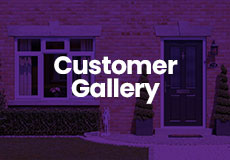
While the classic, clean white appearance of uPVC is the standard you would expect, it’s far from the only colour available for uPVC windows. Here at Windows and Doors we offer a selection of woodgrain styled colours to fit your homes aesthetic. However you want your house to look, we have the product for you!
Let’s go over some of the colours available for you to choose when ordering your windows.
What colour uPVC windows are available?
Our range of uPVC windows has four colours at present for you to choose from, each offering its own benefits to the style you want to display. The options we have available are:
White
![]()
The default for a good reason, white windows have that crisp, clean look that never really goes out of style. It’s super versatile – the colour works on old buildings just as well as it does on a more modern home. If you’re in a newer build, it helps bounce light around and gives a neat, low-fuss finish (they will also, most likely, fit with the windows you already have). There’s a slightly glossy texture too, which stops it from looking too clinical. If you’re after something that fits in pretty much anywhere and won’t age badly, this one’s a safe bet.
Rosewood
![]()
This rosewood finish brings a deep, rich tone that really leans into that luxury feel—it’s bold, a bit dramatic, and has a premium quality. It’s a great match for period homes or more traditional properties, especially if you’re going for that old-world charm with a bit of a polished edge. Think Victorian terraces or older brick houses where you want the windows to feel like part of the story, not just stuck on. It can also work with modern homes if you’re aiming for contrast – like against light or neutral cladding – to make the windows pop a bit more. The dark grain gives it some texture, so it feels authentic rather than flat, and it’s ideal if you like the look of hardwood but don’t want the constant upkeep and degradation risks. It’s definitely one for people who want their windows to make a bit of a statement without shouting about it.
Light Oak
![]()
This light oak finish has a really warm, natural look that makes it feel like real wood. Which is great if you’re after that classic, cosy vibe without the hassle of maintaining actual timber. It fits right in with country cottages, older character homes, or anywhere you want that bit of charm and texture. That said, it also works surprisingly well with newer builds—especially if you want to soften up a modern exterior and make it feel more welcoming. The grain adds a bit of depth, so it doesn’t look flat or fake, and it goes nicely with brick, stone, or even lighter renders. It’s a solid pick if you want your uPVC windows to blend in with more traditional materials but still get all the low-maintenance perks.
Anthracite Grey
![]()
Anthracite grey has become an incredibly popular colour for uPVC windows these days, and for good reason. It’s sleek, stylish and adds that contemporary edge while still being understated. It works brilliantly on new builds, especially ones with a lot of clean lines, big glass panes, or a minimalist vibe. But it’s also showing up more on updated older homes, where it adds contrast and makes everything feel a bit more current. The subtle texture in the finish helps it avoid looking too flat or industrial, which is nice if you’re trying to keep things modern but still a little warm. It pairs well with anything from crisp white render to brick or timber cladding, and it’s great if you want your windows to feel like a design feature rather than just a practical bit of the house.
Are coloured uPVC windows white on the inside?
Not by default, but you can choose to have this design. So, when people go for coloured uPVC windows what they often don’t realise is that the inside doesn’t have to be the same colour. When you select the colours above you can also split it so that the inside remains the typical white uPVC you’d expect. It’s popular because having white inside keeps things feeling light, clean and neutral, which works with pretty much any interior style you’ve got going on, whether it’s modern, traditional, or a bit of a mix.
![]()
![]()
![]()
![]()
Plus, keeping the inside white has a few perks. It can make rooms feel brighter, especially if your window reveals aren’t huge, and it saves you from having to commit to a colour that might clash with your wall paint or decor down the line. A lot of homeowners actually prefer this combo: colour outside for kerb appeal, white inside for flexibility. And if you do want the colour to match inside and out, that’s totally doable too—it just needs to be specified when ordering. So really, you’ve got options either way, depending on the look you’re going for.
Are coloured uPVC windows more expensive?
It will likely come as no surprise but having that extra bit of detail and colour does come with a price tag. The standard calculation is that our coloured uPVC options are about 30% more expensive than plain white. But for that cost you get a wonderful deep colour with extra detail into the bargain.
Whatever your style, our coloured uPVC windows are sure to have something that matches your aesthetic – not to mention, all of our colours and styles are equally available for our uPVC doors if you want the door to match the windows.



















